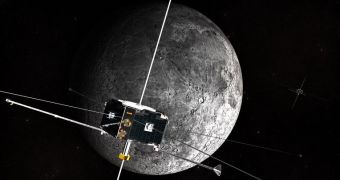Officials at the American space agency announce that the first of the two ARTEMIS spacecraft that have been traveling towards the Moon for more than a year has finally entered lunar orbit successfully.
The mission acronym stands for Acceleration, Reconnection, Turbulence and Electrodynamics of the Moon’s Interaction with the Sun. The two satellites are a part of the former five-spacecraft NASA Time History of Events and Macroscale Interactions during Substorms (THEMIS) constellation.
Before the mission was retired, University of California in Los Angeles (UCLA) expert Vassilis Angelopoulos, currently the principal investigator of the ARTEMIS mission, was the first to propose the lunar transfer.
However, he also realized that conventional boosting techniques would not work, and that the spacecraft would consume all fuel in the process. As such, the two probes took a detour, spending more than 18 months passing through various, never-before-attempted orbits.
Finally, ARTEMIS P1 managed to enter lunar orbit after so much time in space. The event took place starting June 22, after the spacecraft fired its onboard thrusters to exit the libration orbit it was on.
After three successful firing maneuvers took the satellite out of its orbit – where it has been since January 2011 – it spent the next few days heading for lunar orbit. It finally reached its destination at 10:04 am EDT (1404 GMT) on June 27, and was confirmed to be in stable orbit at 12:30 pm EDT.
“This is the culmination of a complex, two-year journey that relied predominantly on gravity boosts and used minimal fuel,” a NASA press release accompanying the announcement reads.
“The path from its orbit around Earth to the moon was developed and orchestrated by engineers at the NASA Goddard Space Flight Center in Greenbelt, Md., NASA Jet Propulsion Lab in Pasadena, Calif., and University of California at Berkeley,” the document adds.
Experts now want to attempt to move ARTEMIS P2 out of its orbit on July 17. They just have to repeat the sequence of maneuvers that they completed with the first satellite, and orbital insertion will be achieved with the second probe as well.
After the current transfer procedure was set into motion, the team began analyzing the science mission that lay ahead for ARTEMIS. “It's a veritable zoo of plasma phenomena on the Moon,” explains THEMIS/ARTEMIS project manager David Sibeck.
“The Moon carves out a cavity in the solar wind, and then we get to watch how that fills in. It's anything but boring. There's microphysics and particle physics and wave particle interaction and boundaries and layers,” he adds.
“All things we haven't had a chance to study before in the plasma,” concludes the expert, who is based at the GSFC.

 14 DAY TRIAL //
14 DAY TRIAL //